
How ancient military science governed defense of the nation
Ancient India was militarily better organized than modern India, reason being the strict adherence to Vedic guidelines and approach to almost all political, foreign, military, and public affairs of the kingdom. Ancient India was so better organized that no other country dared to attack India and if they dared, they were defeated easily. DHANURVEDA is an ancient book dedicated to military science.
Indian defense system is still partially influenced by Vedic military science.
This article reflects the highly advanced thinking and well-sought approach of ancient India commanders/rulers/political advisors in resolving the diplomatic, defense, political, public and foreign affairs of the kingdoms
Also read
Chakravyuha-The most deadliest and brilliant military formation
Honor and special facilities provided to defense personnel in ancient india
Fourfold defense system of ancient india
Different military formations of Mahabharata and ancient indian wars
Vedic guidelines to govern the defense of the kingdom
In ancient India, governing the kingdom required lot of experience and knowledge in diplomatic, defense, political, public and foreign affairs. King/prince was properly trained by his guru (sage) to understand the different aspects of political governance and the correct approach in finding the solution to the various problems happening in his kingdom.
<>
All princes necessarily had to learn religious scriptures, military skills, servitude of sages/elders/public and art of public administration from the bonafide guru before he is certified fit to be the king.
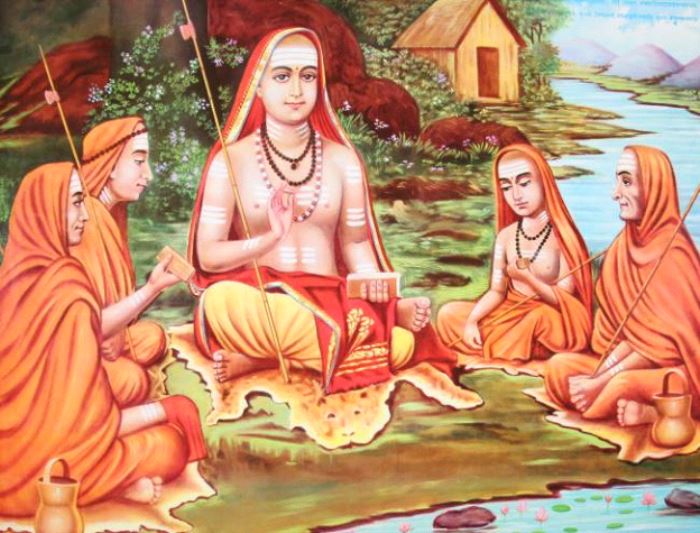
Disciples learning from guru in gurukul
Also read
Chanakya Arthashastra-Greatest book on spying and secret agenies
Chanakya-The greatest diplomat cum politican of all times
Why India never invaded any other country
Below are some of the guidelines suggested in Vedas on military affairs of the nation:-
Ministry of defense-governs the defense of the kingdom
Three advisory councils were formed by the king to properly govern the kingdom out of which, one council role was to advise king on matters of defense. Council in modern terms can be termed as “Ministry of defense”. Efficiency of the army and strategical decisions was decided by members of this council. No decision on matter related to military affairs was taken without the consent and clearance from “Ministry of Defence”. Instead of Bureaucrats, “Ministry of Defense” in ancient India was managed by experienced military planners/commanders
O members of the council, I know the nature of the powers, since you are called Narista (whose orders are bound to be obeyed). People shall obey your order. All the members of this council have to work collectively-(Atharveda.7.12.2)
General National Service
“General national service”, as described in the Indian constitution (Part IV-A), is also derived from Vedas. All nationals of the country have equal responsibility in the security of the nation. Every citizen must give few years of life in the service of the nation. During the Vedic era, brahmacharis were given military training in Ashrams. Citizens were recruited and trained every year and then, were posted in different regions of the country. During times of danger, cadets of national service are asked to take arms to defend the nation. NCC (National Cadet Crops) is said to the modern form of General National Service. Though not recognized by the government, RSS is also a form of “General National Service”
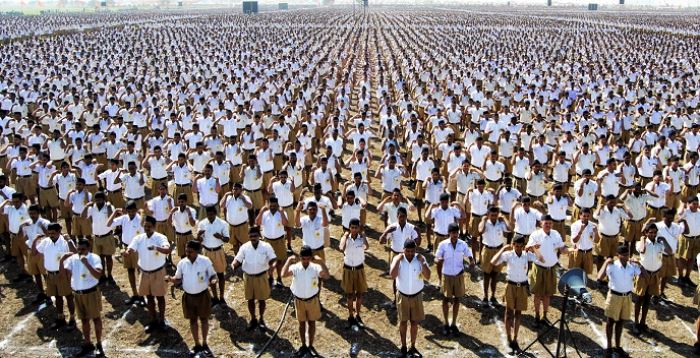
RSS- world's largest voluntary non-governmental organization devoted to cause of the nation
<>
Tri-Service (Army, Navy and Air Force)
Similar to modern times, forces of ancient era was also divided in three categories viz. land, sea and air. Below are the verses on each one of them :-
(a) Land forces: - (Army)
Land and the people residing on it, shiver when the brave warriors march over, with all their equipments, bands, etc.-(Rig.1.38.10)
Brave warriors you gracefully go both on land and in air. The vehicles will follow your path-(Rig 1.55.7)
O Commanding Officer! You are the holder of these lethal weapons, which have three edges, three effects and are effective against the enemy on earth, outer space etc. People on earth. And in air or in other heavenly regions accept your power-(Ath.11.10.2)
Warriors of the country, countless in numbers and in a very great strength march on the earth in lines and are posted at different places.-(Yaju 16.54)
(b) Air force:
I have already written many articles on ancient Vimanas.
Also read
Interstellar travel and aerial flying chariots-Part 1
Interstellar travel and aerial flying chariots-Part 2
Airplanes or flying Vimanas of ancient India
Pushpaka Vimanas-The first flying airplane on earth
Mindblowing vimanas or airplanes of mahabharata
Shivkar Talpade-The first human to build modern airplanes
Types of ancient vimanas
Generation and use of electricity in vedic era
Below verses again validates the existence of vimanas in ancient world
Those warriors (air men) who come by aeroplanes are free from the effect of dust
(Rig.1.168.4)
O warrior! You come through the shining sky.-(Rig.1.6.9.)
Warriors! Your enemy cannot trace you out in the space.-(Rig 1.39.4)
We bow to you, O soldier, who flying in the outer space protects those living beings there.-(Ath 11.2.4.)
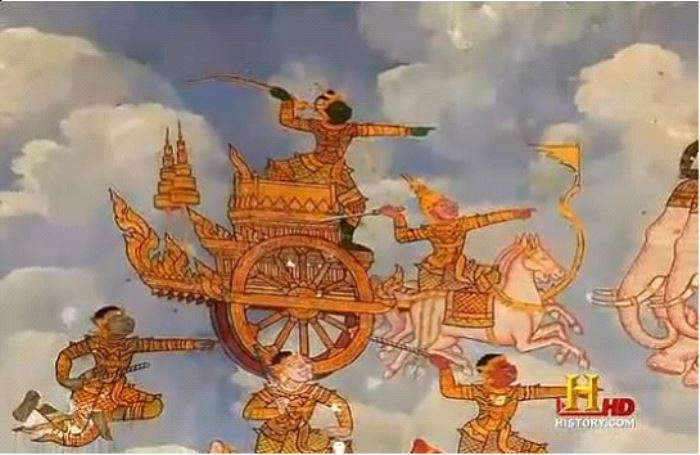
Airplanes of ancient India
(c) Sea force (Navy)
Navy of ancient era was not as developed as it is now. It may be because enemies never fought war on water. Ships were just used to transport food, ration, wealth, arms and ammunition etc.
The ships (sea horse) carry away necessary wealth, ration etc. for those soldiers who are stationed beyond sea.-(Rig.1.167.2)
In this mantra a warrior is described as bird who travels in the sea under water, which fact indicates that soldiers go under the sea, viz. in submarines.- (Rig.5.52.9)
<>
Commissariat
Commissariat was an administrative division whose role was to assist the army-men in providing food, medicines, weapons, clothing etc. Centuries before the modern army realized the use of this division; it was the Pandavas of Mahabharata who marched to Kurukshetra with carts, transport cars, treasury, weapons, physicians, surgeons, veterinary doctors and other administrative officers. Numerous references to Commissariat in various epics conclude that war were well-planned and conducted systematically.
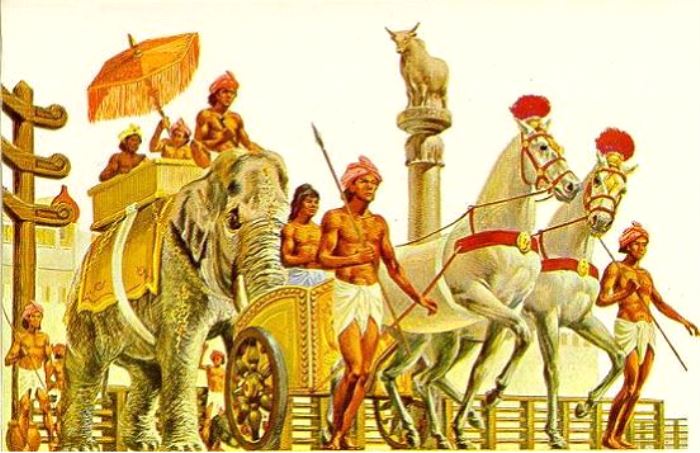
Commissariat protected by army
The Admiralty:
Admiralty was the special department for naval unit of the army. Though use of ships and boats has been in use since the Vedic period, creation of a separate department for naval administration, driven by the increasing use of naval routes, was the idea of Chandragupta Maurya.
'this exploit you achieved, Asvins in the ocean, where there is nothing to give support, nothing to rest upon, nothing to cling to, that you brought Bhujya, sailing in a hundred-cared ship, to his father's house." (Refer to Naval warfare section).
In Vedas, we find references to extremely talented woodworker known as Rajyadhara and Pranadhara, who were so skilled in creating huge intricate ships that they were called as “ocean crossing chariots” or flying chariots. Travelling at the speed of thought, such ships would carry thousands of passengers in a single trip.
<>
Cartography
There was a special department dedicated to creating maps of neigbouring kingdoms. Maps in ancient India were depicted in the form of painting or a picture. Evidence of this is found in New History of the T'ang Dynasty in which there are references to use of maps by the south Indian kings for planning strategies against invasion or for attacking another kingdom.
"The charts in use by the medieval navigators of the Indian Ocean - Dravidas, Arabs, Persians, were equal in value, if not superior, to the charts of the Mediterranean. Marco Polo (1498) found them in the hands of his Indian pilot, and their nature is fully explained in the Mohit or 'the Encyclopaedia of the Sea'
Fight war for defense of the nation
According to Vedas, War with other kingdom was sought only when the opponent attack first or intend to attack first. War was never fought for acquiring wealth, territory, or resources of any other kingdom. This is unusually opposite to the tenets of Christianity and Islam, both of which continuously attacked other countries for dominance, wealth and resources. Ancient values are so strongly fused in Indian blood that till date, India has never invaded any country though they have been invaded numerous times. Since 1947, India fought 4 wars with Pakistan and 1 war with china but not even one of these wars were started by India.
O brave warriors, rise with your banners and prepare yourself for (battle) to protect the territorial boundaries of the country. O snake like swift warriors, O demons like men and other people, chase the enemy who attempts to attack.
(Rigveda.5.54.14) (Atharveda.11.10.1)
O warriors, you cannot be conquered by any one, you cannot be killed or subdued by any one; but you do not trouble any one nor plunder any area. You are assigned to protect the Kingdom-(Rigveda.5.54.7)
<>
Commander in chief commands defense of the kingdom
In Vedas, defense of the kingdom is said to be under command of the chief, who has been addressed by various names like Rudra, Arbudi, Nyarbudi etc. To define the policy related to defense, a committee of experts known as samiti or sabha is constituted.
Here Rudraya means the commander-in-chief and Samiti issues instructions to him to fight out the enemy who is out to disturb peace in the country- (Atharveda .4.30.5)
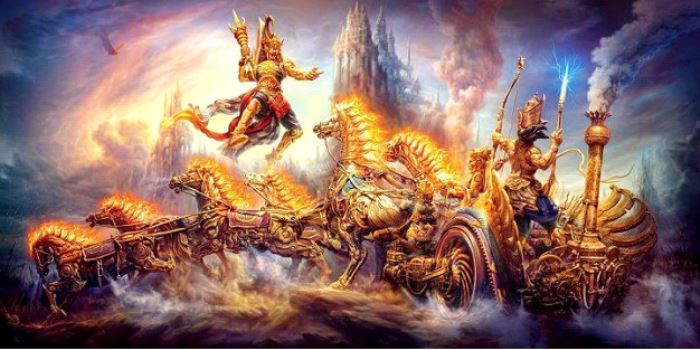
Karna-Commander in chief of kaurava army
Qualifications of commander-in chief:
In Vedas, commander-in chief is addressed as Rudra or Maruta, both of which defines his virtues. Rudra means fearless and Maruta means Agile in action.
Commander-in chief should be intelligent, experienced, physically very strong and must be ever-ready to command and protect the country from internal or external attacks of enemies.
O commander-in-chief! You are capable of taking to task the wicked persons. You possess the capacity and power to annihilate the enemy. You are equipped with requisite weapons. We pay our respect to you-(Yajurveda 16.1)
Virtues of commander-in chief:
Some of the virtues desired in commander-in chief are described below:-
(1) Kavim - Fully acquainted with military strategies and techniques of fighting a war (Rigveda.1-114-4)
(2) Shvitichey- Having commendable character and personality. (Rigveda.2-33-8)
(3) Vajrabahu - One with strong arms like that of a sword. (Rigveda.2-33-3)
(4) Pururupa - Capable and experienced in handling all kinds of situations. (Rig.2-33-9)
(5) Sahasrakshaya-Possessing a very watchful eye or extremely focussed. (Yajur Veda)
(6) Avevirah-Outstanding warrior. (Atharveda.:19-12-2)
O commander-in-chief, you possess the capacity to fight out the enemy. You deploy weapons for destroying the enemy and protect the boundaries from invasion.
(Yaju 16.3)
O brave warriors! March on fast, attack the enemy according to command of your officer, chase the enemy as a wolf worries the sheep, let not the enemy go out of your clutches alive, Stop his breath (kill him).
( Ath.5.8.4.)
Qualifications of a Warrior/soldier
The most desired qualification of any warrior is extreme love for the motherland. He should be willing to sacrifice his life, soul, family, relations and all comforts for the protection of the motherland. Furthermore, a good warrior is expected to have more or less all qualities of the army commander. He should be brave, courageous and expert in the use of weapons and riding horses, chariots etc. Below are some of the desired qualities required to become a warrior?
(i) Urga-Swift to take action(Rig.1.19.4)
(ii) Indomitable courage-(Rig.1.19.4)
(iii) Fearless-(Rig.1.19.5)
(iv) Bright-(Rig.1.37.2)
(v) Who is always ready to die for the motherland? (Rig.1.37.1)
<>
Qualifications of women warriors
Joining the army was not limited to men. Courageous and valiant women were also inducted in the army provided they have all the qualities of a warrior listed above.
O queen, the slayer of foes, organize the band of the army of women, that may bewilder the hearts of the forces of the enemy, remain aloof from sin, convey him to thy Soldiers, burn down the foes, whereby they may abide in utter darkness with hearts full of grief.(Yaju 17.44)
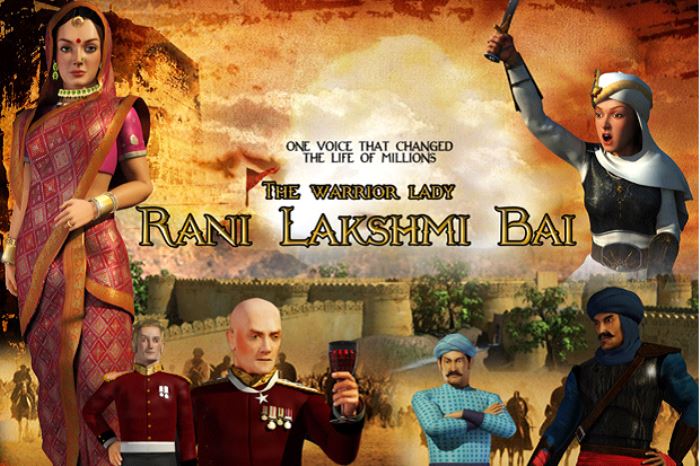
Rani Lakshmi Bai-Ferocious queen who terrorized the British administration
Though, inclusion of women warrior in the army was never encouraged, there are many instances in Indian history where women warriors have not only fought, but also led the army against the attack of enemy kingdom. Influenced by value-based scriptures like Vedas and Upanishads, many women warriors and queens have glorified their names in Indian history. Ex: “Rani of Jhansi”, “Ahilyabai Holkar” etc.
<>
Equipment for the army
Army cannot win the war if they are not fully equipped with the latest weapons and equipment’s. All essential weapons, medicinal equipments, vehicles, artillery, fighter planes & tanks should be provided to army-men. All these Vedic verses to defend the country have been ignored till now by previous governments. Under the leadership of “narendra modi” and smart strategists like “Ajit doval” and “Manohar praikkar”, government is increasingly taking measures to provide all modern equipments and facilities to defense forces.
O you the producers of arms and ammunitions : (ordnance factories) and you the supplier of the same, vouchsafe that the arms you are supplying are in good condition and shall never fail while in use by the warriors who are wholly and perfectly devoted to defend their mother land.(Yaju 16.10)
<>
A brief list of weapons, referred to in Vedas, is given below:
1. Equivalent to modern nuclear bomb - (Yaju 33.46)
2. It emits rays to destroy the enemy-(Yaju 10.21), (Yaju 10.22)
3. It is not thrown like a bomb but used in fighting-(Yaju 16.11)
4. It is a very strong weapon-(Yaju 15.16).
5. It consists of three joints almost like a rocket-(Ath.11.10.2)
6. In this weapon, small pieces of iron are attached-(Ath.11.10.3)
7. It has a pin like nail at the mouth-(Ath.11.10.3)
8. This weapon spreads smoke. (Ath.11.10.1)
9. This weapon makes the enemy senseless.(Ath.11.10.7)
10. It emits tear gas.(Ath.11.9.7)
11. It emits fire.(Ath.11.9.19)
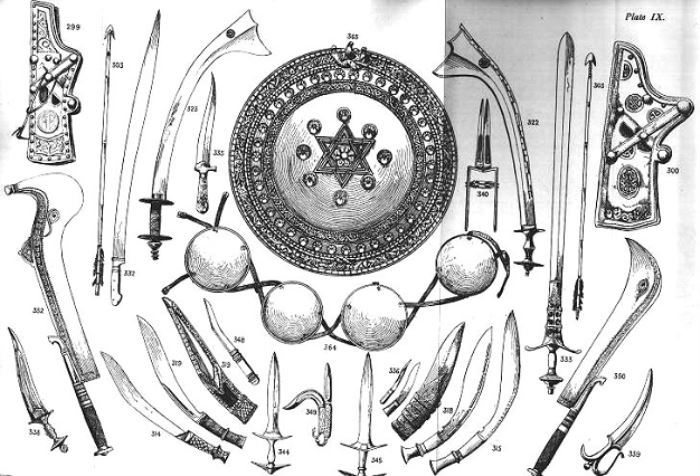
Equipment of ancient Indian army
In addition to the above weapons, army-men were warranted to be acquainted in various kinds of traps mentioned in the Vedas to deceive and capture alive the opponent warriors. Some of them are
(Jaiyapasha) (Ath.11.10.25), (Kavach Pasha) (Ath.11.10.25),(Naga Pasha) (Chakra Pasha), (Padma Pasha).
O the effluent commander, you with your hundred kinds of weapons and Pashas can push the enemy back. (Yaju.16.53)
O commander-in-chief, the thousands of weapons and traps that you possess can tear off the enemy.(Yaju 16.52)
<>
Summary:
Thus, we see how significance of Vedas is not limited to spiritual enlightenment but is also a perfect guide to general warfare and military science. Had such guidelines been followed seriously by Indian kings and Indian government, we would have been living under a prosperous and powerful India. Next article will be on facilities recommended in Vedas for defense personnel’s as well as military strategies/tactics
Note: Images used on this website
are either a production of Bhaktivedanta Book Trust(https://www.krishna.com), Iskcon
Foundation or were found in google search under "Free to use and share". If any
of the images presented here violates copyright issues or infringes anyone copyright
or are not under "Fair use", then please bring it to our notice. Read
Disclaimer for more.
Share this to your friends. One of your friend is
waiting for your share.
Related Articles
Steve jobs and zuckerberg temple and guru neem karoli baba
Interstellar travel and aerial flying chariots-Part 1
Bhagavad gita quote against caste system
Vedas Quotes Against Present Caste System
Shivkar Talpade-The first human to build modern airplanes
Varna System-Caste System is the need of society
Post Comment